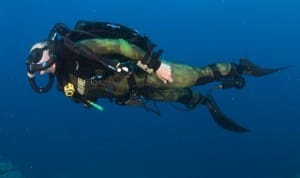The Joint Program Executive Office Joint Tactical Radio Systems (JPEO-JTRS) is developing the Rifleman Radio as part of an effort to bring secure, networking capabilities to the intra-squad level.

The Rifleman Radio will be interoperable with other Joint Tactical Radio System products, to allow needed connectivity to higher echelon command elements. Photo by: Jason Bock (C-E LCMC)
The Rifleman Radio is interoperable, software programmable and upgradable and employs the Soldier Radio Waveform. It is ruggedized and light, includes a convenient push-to-talk, and a hands-free headset. The system is self-networking and will expand and contract as radios are added or subtracted from the net. Recently tests of the new radio were conducted at Fort Bliss, Texas with the 1st Armored Division.
“Right now, the individual Soldiers and their squad leaders are the biggest have-nots within the communications arena,” said Maj. Tracy Mann, of the TRADOC Capability Manager for Tactical Radios. “This capability will allow squad leaders and team leaders to talk directly to their subordinates, and their subordinate leaders to be able to command and control their individual squad and platoon battle troops.”
By employing a National Security Agency Type 2 certification, the Rifleman Radio can offer controlled but unclassified communications a Soldier can employ without requiring security clearances. This solves one radio problem for infantry units, which are comprised mostly of troops who are not cleared. The NSA Type 2 encryption bars classified information from being passed during transmissions and makes secure information more difficult for enemies to intercept. With these factors in place, the Rifleman Radio will not only deliver 10 to 100 times the bandwidth to the tactical edge, but at the same time, make sharing information more secure for the Soldier.
In addition to voice communication, the Rifleman radio also supplies a commander with a GPS picture of his squad members through a Position Location Information, or PLI, display. At Fort Bliss, the 1st Armored Division used the GPS features of the Rifleman Radio in a shoot-house situation. Squad leaders positioned outside of a darkened room were able to locate and identify the positions of each member of their team through the PLI.
The Rifleman Radio is being developed as a stand alone system, but will integrate into the Ground Soldier System Ensemble platform providing mission planning, execution, and situational awareness capabilities to squad team leaders and above. The Rifleman Radio will also be interoperable with the other suite of JTRS products being developed including the Ground Mobile Radio and HMS Manpack radio, to provide the needed connectivity to higher echelon command elements.























































































































